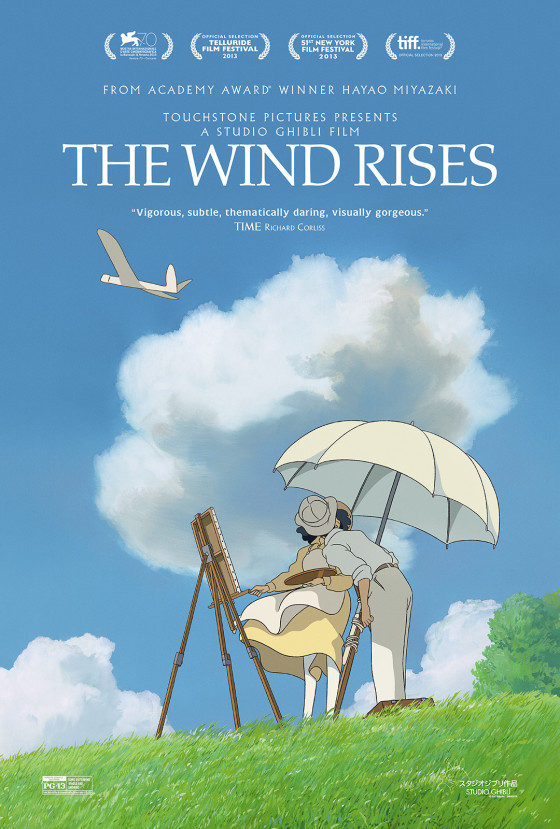The Wind Rises (Miyazaki, 2013): Japan
Reviewed by Larry Gleeson. Viewed at the AFI Filmfest 2013.

“The Wind Rises,” is a new animated, full-length, feature film from legendary Japanese animation director, Hayao Miyazaki. Miyazaki announced at this year’s Venice Film Festival this will be his last film. In 1997 his “Princess Mononoke,” was the highest revenue grossing film in the history of Japan at the time of its release and it also received the Japanese equivalent of an Academy Award for Best Film. Miyazaki is also well known for the films “Spirited Away,” (2001) and “Howl’s Moving Castle,” (2004) In 2003 Miyazaki received an Oscar for Best Animated Feature for the film “Spirited Away,” His films have garnered international acclaim from critics and have provided Miyazaki public recognition within Japan. His films are known for compelling characters, engaging plots and eye-catching animation. Remarkable by today’s standards his films allow no more than 10% of the footage to come from computer animation.
In “The Wind Rises,” Miyazaki tells the story of Jiro Horikoshi, a real-life aeronautical engineer who designed fighter aircraft in Japan during WWII. The film opens with the young Jiro fantasizing of his plane flying above his hometown. As I watched the scene unfold, a rather powerful ominous feeling surfaced as I was reminded of Leni Riefenstahl’s opening scene from the Nazi propaganda documentary, “Triumph of the Will.” Nevertheless the early moments of the film are very heartwarming as Miyazaki chooses to highlight Jiro’s youth as an older brother to a delightfully spirited younger sister in a single parented household run by their kind and caring mother.
Jiro’s passion throughout the film is making good airplanes. Jiro’s daydreaming, which he does a few times during the story’s arc. Admittedly, several of my favorite moments are Jiro’s imaginings with Count Caproni, a larger-than-life mustachioed Italian airplane designer who mentors Jiro with playful and good natured ribbing, and provide insight into Jiro’s creative passion. Jiro finds his inspiration through such moments and Miyazaki makes space for them throughout the film.
The story is partially based on Tatsuo Hori’s 1938 novelette, “The Wind Has Risen.” Miyazaki’s animation provides beautiful plush scenery with Monet-like backdrops and landscapes providing striking visuals while creating a powerful nostalgia for a simpler time lightly brushing over the complications of war and economic depression. With such a breathtaking mise-en-scene it’s no wonder a young Jiro falls in love with the young woman he saved during a traumatic, historic earthquake a few years before (the 1923 Great Kanto Earthquake). In direct juxtaposition to this frantic and rather manic scenario in the aftermath of the earthquake, young Jiro finds himself vacationing in a rural setting enjoying the greenery and the soft “rising” winds complete with majestic and billowing, flowery clouds when he coincidentally crosses paths with the beautiful girl he saved from the earthquake as she paints poetically on a hillside overlooking the spectacular countryside.
“The Wind Rises,” is a very light-hearted film, entertaining film. The film focuses pretty much exclusively on the protagonist, Jiro as an idealistic engineer whose primary purpose in life is to make planes. Granted, he falls in love and rubs elbows with German plane builders during WWII. Yet, WWII and the social unrest after the Great Kanto Earthquake are left virtually untouched. Tellingly, Jiro’s concern at the end of the war was over the planes that didn’t come back. Nevertheless, I wholeheartedly recommend the film for children and for adults with a penchant for Monet-esque visuals.
About this entry
You’re currently reading “The Wind Rises (Miyazaki, 2013): Japan,” an entry on Student Film Reviews
- Published:
- 11.15.13 / 10pm
- Category:
- AFI Filmfest 2013, Animation, Films
No comments
Jump to comment form | comments rss [?] | trackback uri [?]